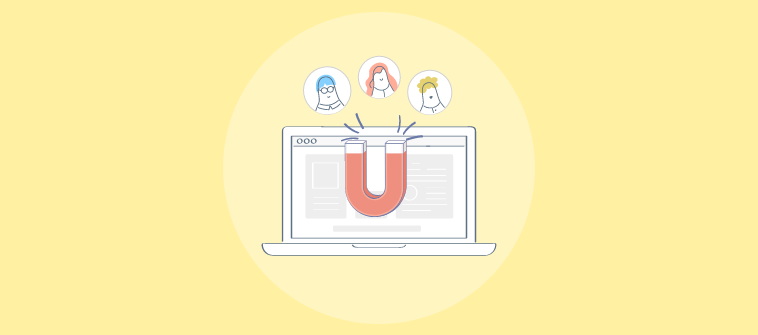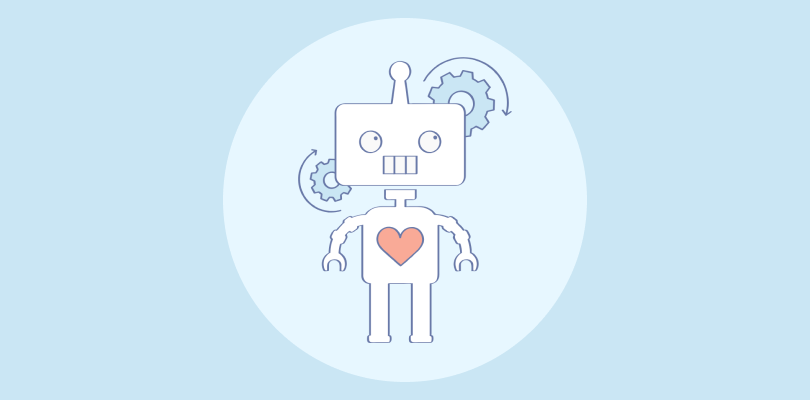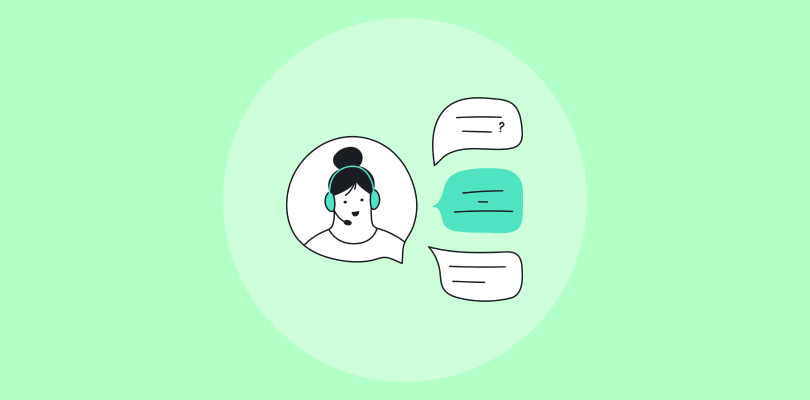Sales, Marketing, Human Resources, all these departments are known for illustrating the user journey using a funnel. But what about customer service?
For businesses, it’s time to rethink the customer support funnel. While no two companies are created in exactly the same mold, they can all use a support funnel to guide their customers to become loyal brand advocates.
A well-optimized funnel can help your business map the customer service journey, create support strategies that cater to different customers in different stages, and enhance the customer experience.
So if you are an entrepreneur looking to retain your audience or a customer success manager striving to enhance the support experience, this blog is for you.
In this blog, we will understand the benefits of a support funnel, discuss the role of customer support software in capturing relevant metrics, and show you how to build a customer support funnel.
But first, let’s start with the basics.
What Is A Customer Support Funnel?
A customer support funnel is a term for the journey your customers go through from purchasing a product to becoming loyal brand advocates.
There are fours stages of the support funnel- onboarding, after-sales service, retention, and finally advocacy. Depending on which stage a customer is at, you can devise relevant strategies and personalize their support experience.
So how is the customer support funnel different from the sales funnel?
The sales funnel encompasses the buying process and involves the initial stages of the customer journey such as awareness, discovery, intent, and purchase. On the other hand, the customer support funnel involves later stages of the customer journey such as onboarding, retention, advocacy, etc.
Why You Should Build Customer Support Funnel
In addition to understanding the customer journey, building a customer support funnel has many advantages. Let us explore some of these benefits in detail:
1. Retain Customers For a Long Time
A majority of businesses spend a large proportion of their budgets acquiring new customers, which means that the needs and expectations of existing customers are overlooked at times.
According to a Forbes article, it can cost five times more to attract a new customer, than it does to retain an existing one.
When you optimize the customer support funnel to meet the support needs of different customers, you enhance their satisfaction, reduce churn, and retain them for a long time. You will be surprised to know that even something as small as a 5% increase in customer retention can help your business produce 25% more profit.
2. High-Value Customer Interactions
If you map the customer journey, you will realize that different customer have different needs as they move up and down the various stages of the support funnel.
For instance, while a new customer might need video tutorials to get started, an existing customer might demand loyal reward points or discounts.
A well-defined customer support funnel will help you hold meaningful and high-value interactions with customers no matter at what stage they are. You can proactively communicate with them about ongoing issues instead of waiting for them to reach out to your business.
3. Generate Positive Word of Mouth
Whenever we like a product or service, we don’t think twice before recommending it to our near and dear ones. In today’s digital world where a single review spreads like wildfire, businesses have come to recognize the word of mouth’s growing importance.
A well-managed support funnel can help you deliver memorable support interactions which further leads to more recommendations. According to a study, customers who rate a company’s service as “good” are 38% more likely to recommend that company.
Great customer experience can foster positive word of mouth, which can eventually reduce your brand’s marketing expenses. In simpler terms, your existing customers do the job of your marketing team and help you get more customers.
4. Boost Sales With Upselling Opportunities
Customer support teams are often overlooked when we consider the concepts of upselling and cross-selling. They often interact with customers after the product has already been sold and therefore, have little to do with sales. But this is simply not true.
Many customer service interactions present several opportunities for support reps to persuade customers to buy higher-value products, leading to increased sales.
For instance, you can leverage chatbots that can assist customers while they are shopping online. AI-powered bots can recommend higher value or complementary products based on a customer’s shopping history and searches. Chatbots can also be used to remind online shoppers that they have items added to their cart.
Stages of the Customer Support Funnel
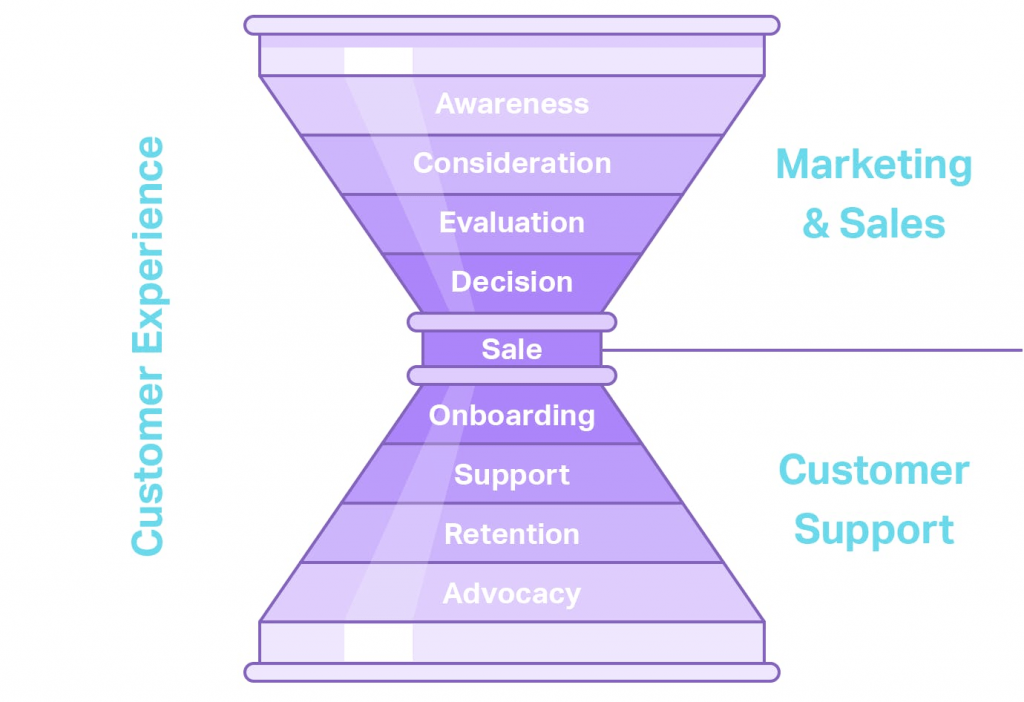
The various stages of your support funnel can help you channelize your customer service efforts. These stages cover a significant part of the customer journey, right from customer onboarding to advocacy.
Stage 1: Onboarding
Right after a successful sale is made, your customers need to be introduced to your product or service. They might have heard about what you sell or even used your product before. However, a smooth onboarding process will set them up for success.
Customer onboarding is the first yet most important stage of the customer support funnel. Through this process, you can get your customers acquainted and comfortable with your product/service. But what happens when onboarding goes wrong?
Poor onboarding is a leading cause of customer churn. In fact, around 23% of customers can churn if they are not provided with a delightful onboarding experience.
Here are some tips for successful onboarding:
- Highlight value by showing how your product can solve customer problems
- Upload getting started video tutorials on your website or help center
- Create other engaging content such as FAQs, help articles, etc.
- Ask your customers what you can do to improve the onboarding experience
Stage 2: After-Sales Service
Right after onboarding, customers enter the next stage in the support funnel where they start using your product to solve their day-to-day problems.
In the customer support funnel, after-sales service is an important stage where support agents offer assistance to customers after they have made the purchase. Delightful after-sales service can lead to higher customer satisfaction and brand loyalty.
Your customer support team’s role becomes pivotal during this stage. They need to resolve all customer queries or issues in a timely manner for a positive support experience.
Some important communication channels or touchpoints of this stage are self-service, live chat, email, phone, web forms, etc. Now, customers can have different expectations with these different channels. For instance, while customers prefer an instant response over live chat, they are fine with receiving an email response within 24 hours.
Stage 3: Retention
Once your business gets the first two stages of onboarding and after-sales support right, you will notice that customers are not hesitant to buy again from your brand.
This is the retention stage of the customer support funnel where you need to proactively engage with customers. You need to proactively educate them about product updates, complimentary products, best practices, trends, and more.
The objective of every business must be to ensure the majority of customers are retained for a long time. This will help you increase your sales with more repeat purchases.
Here are some steps you can take to encourage customer retention:
- Engage customers with relevant content on social media platforms
- Update customers about your new offers, discounts, etc.
- Create loyalty programs to reward your loyal customers
- Expand your relationship by being your customer’s trusted advisor
Read More: Top 10 Strategies for Building Brand Loyalty that Lasts
Stage 4: Advocacy
Advocacy is the final stage of the customer support funnel where customers become loyal brand advocates. Only a few customers reach this stage but they can help you promote your brand to their friends or family.
But what exactly is brand advocacy?
In the advocacy stage, customers love your product so much that they don’t mind recommending it to people they know. In simpler terms, customers do the job of your marketing team, and that too for free.
To facilitate advocacy, you need to connect your existing customers with prospects. You can politely ask your customers to share their reviews on social media platforms, your business website, product review platforms, etc.
In addition to this, you can also create an online community forum where your audience can share ideas, experiences, discuss industry trends, product hacks, and more. Connecting customers via community forums helps establish your product’s value and spread the word to potential customers.
How to Build an Effective Customer Support Funnel
Creating an awesome customer support funnel strategy is not rocket science. Here are some strategies your business can use today:
1. Keep Things Simple for a Better Onboarding Experience
We all remember our first experiences – be it our first date, first college trip, or the first time we use a product. Therefore, a lot is at stake when you onboard your new customers.
Instead of bombarding them with too much information, take things slowly. Whenever customers log in to their accounts using your website or mobile app, you can direct their attention to important information.
For instance, Slack displays onboarding information when users use Slack for the first time. This helps users discover aspects of the collaboration tool and leads to a better learning experience.
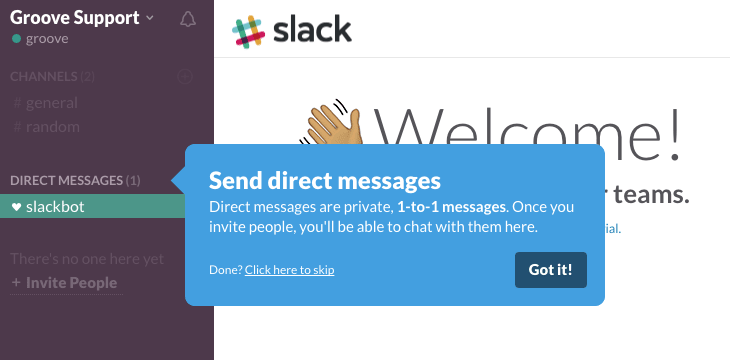
Instead of expecting your customers to become masters at using your product, appreciate them for the small steps they take. For instance, once a customer has added their complete account details, you can share messages as “Good job, you are all set!”, or “Give yourself a pat on the back”.
Once these small steps are completed, you can finally show off your product features.
2. Offer Multiple Communication Channels
Customer touchpoints today are no longer limited to in-store visits. With the advent of the Internet and mobile devices, digital channels have taken over the scene. Whether it is about buying a product online or seeking necessary support, customers can get everything right at their fingertips.
According to a Statista report, around 20% of US customers prefer email and 38% of them prefer digital channels (live chat, self-service, social media, etc.) for contacting a business and resolving their customer service issues.
As a first step, it is important to identify the channels that are preferred by your target audience. Rather than focusing solely on traditional communication channels such as the phone or email, try to incorporate more digital channels such as live chat, knowledge base, social media, and more.
The next step is binding all the channels together for a seamless omnichannel experience. For instance, a customer can book your product online and then visit your store for a hassle-free shopping experience.
3. Encourage Self-Service With Engaging Content
Good content is eternal. The content that your brand creates will stay forever and is probably one of the best investments you can make in this digital era.
Well-curated self-service content not only helps customers who are in their onboarding stage but also those who have moved up the funnel. For instance, your existing customers can refer to FAQs every time they feel stuck with your product.
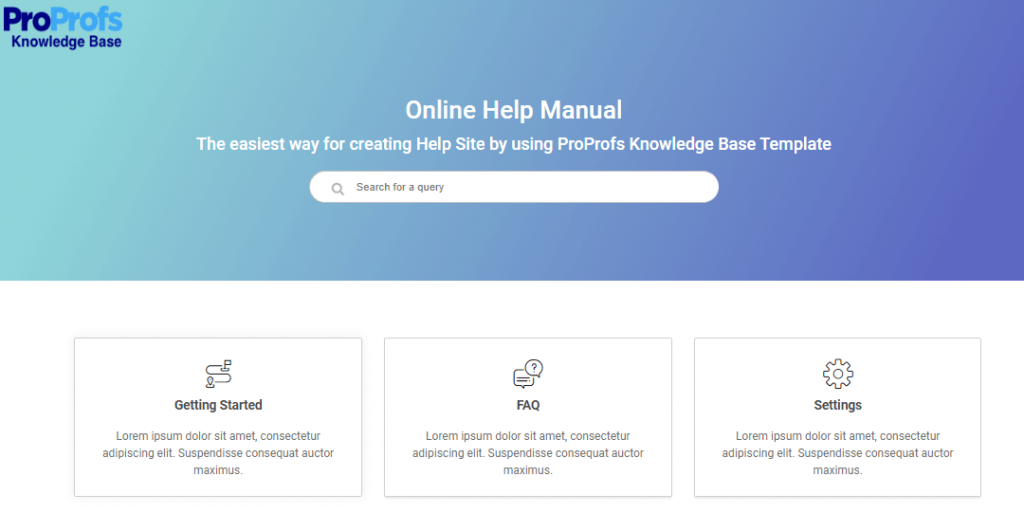
Your next priority must be to make your knowledge base ridiculously fast and easy for your audience to find the answers they seek. You can begin by raising strong questions such as:
- Is our Help Center easy to navigate?
- Is our search bar powerful and does it deliver precise results?
- Do our customers prefer interactive videos or help articles?
The more thought and consideration you put into your self-service portal and content, the less customer tickets you will have to handle.
Read More: Effective Tips to Promote Your Self-Service Platform Among Customers
4. Stay Available 24×7 With Chatbots
AI-powered chatbots are revolutionizing the entire customer service landscape. According to a recent study, around 74% of customers prefer chatbots while looking for answers to simple questions.
Chatbots are programmed to scan through massive chunks of data to provide customers with quick answers in nanoseconds. Hence, they can be great for assisting customers with their simple and repetitive questions.
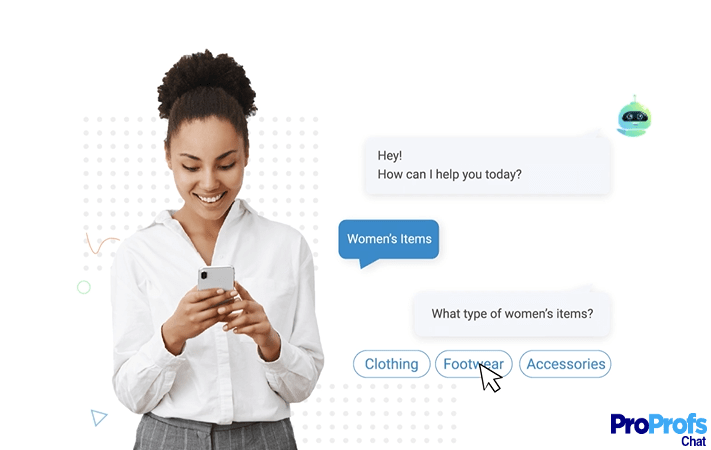
Let’s look at some popular benefits that chatbots can help you enjoy:
- Offer Round-the-clock customer support: Chatbots can help you assist customers 24×7. Even when your team is offline at night or during holidays, bots can interact with customers and resolve their basic queries.
- Reduce support costs: Every customer interaction with an agent is costing your business dollars. By adopting chatbots, you can deflect a majority of support tickets and reduce costs. Moreover, your team can focus their valuable time on more urgent issues.
- Route conversations to the right people: AI chatbots understand customer context and even emotions. Therefore, they can ask customers initial questions and then route them to a relevant team member or department.
5. Monitor Your Performance With a Customer Service Software
How do you know if your business is moving in the right direction if you are not measuring your progress? To set up your customer support funnel for success, you need to monitor your performance at regular intervals.
By monitoring your team’s performance you can understand the bottlenecks in your support operations, measure the performance of your agents, and see aspects that are making your customers really happy.
But here comes a challenge. How do you track and measure customer service metrics? Well, powerful customer service software can help you automate your reporting process. Managers can generate daily, weekly, or monthly reports and improve the customer experience. Here are some popular metrics you can track using a customer service tool:
- Average First Response Time
- Ticket backlog
- Help article ratings
- Customer Satisfaction Rating (CSAT)
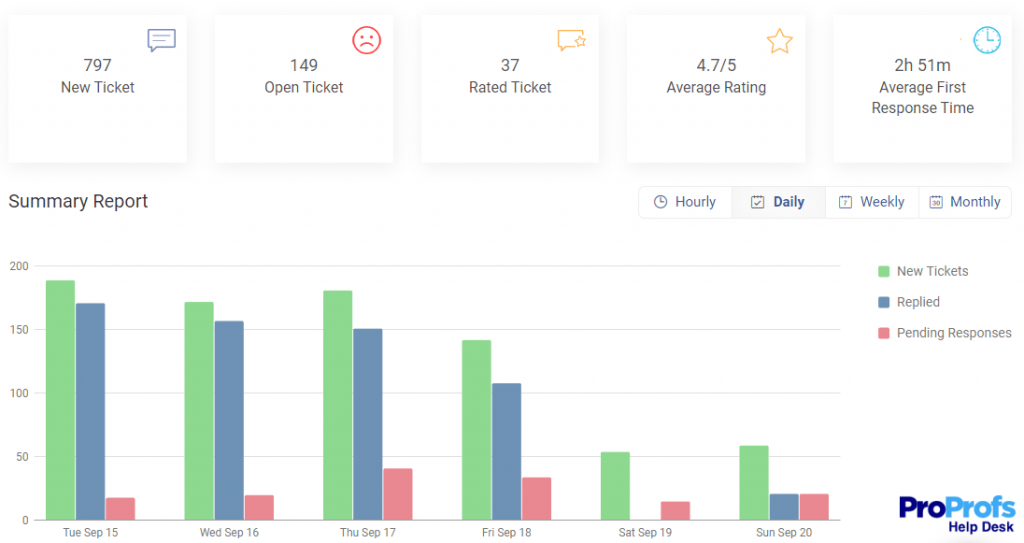
In the below section, we will explore more such metrics and their role in improving your customer support funnel.
Read More: Top Benefits of Customer Service Reports
Metrics for Your Customer Support Funnel
Now you might wonder, “Is there is any way to know if our customer support funnel is working?” Yes, there are a few customer service metrics that you can start tracking today for the same.
- Customer Satisfaction (CSAT)
For a well-managed support funnel, you need to consistently measure your customers’ satisfaction levels at each and every stage of the funnel. You can share CSAT surveys with your customers and ask them to rate how happy they are with your onboarding process, self-service, customer service reps, and overall support quality.
This will help you see how your customer service team is performing and what they can do to make the transition from one stage to another as smooth as possible.
- Net Promoter Score (NPS)
Net Promoter Score or NPS is another crucial metric that can help you identify your loyal customers. You can measure how likely customers are to recommend your brand to their friends or family members. Let’s see what an NPS survey looks like:
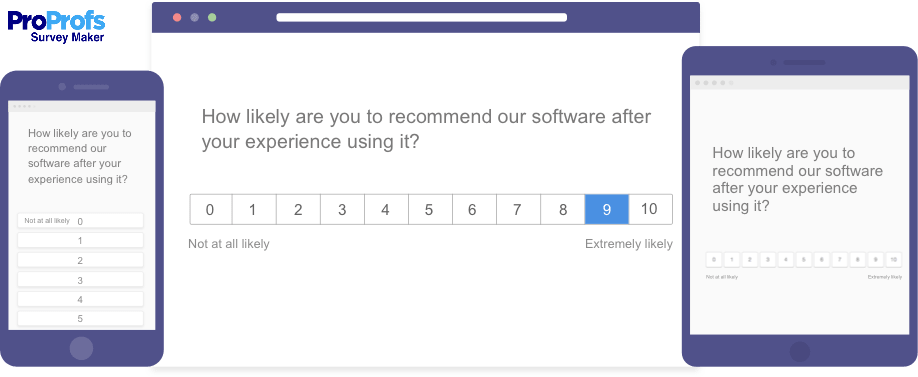
Now, it is important to remember that there is no point in measuring NPS during the early stages of the support funnel as customers have not made their minds yet. It is more logical to share NPS surveys during the Retention and Advocacy stages to identity your active promoters.
- Customer Effort Score (CES)
For measuring your customer support funnel’s effectiveness, you need to prioritize the Customer Effort Score. The metric measures the amount of effort a customer had to put in to get an issue resolved or a request fulfilled. This is what a CES survey looks like:
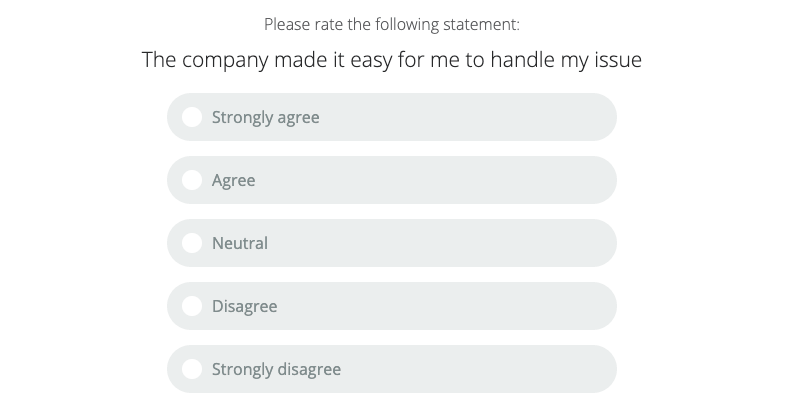
CES surveys can help you measure the effectiveness of your support strategies. For instance, during the Onboarding process, you can understand if customers are struggling to search for help articles in your knowledge base, or finding it difficult to contact your support team.
Read More: How to Calculate Customer Effort Score to Grow Your Business
Exploring the Conversational Support Funnel
The conversational support funnel is an interesting strategy to blend both proactive and reactive customer service. The main objective of the conversational support funnel is to filter out simple and common customer issues so that your human agents can focus on the real issues.
Proactive: This stage is all about being proactive and staying ahead of problems before customers reach out. For instance, in case of downtime, you can share proactive notifications with customers via SMS, email, Twitter, etc., and inform them about the problem. This will allow customers to adjust their expectations rather than bombarding your support team with questions.
Self-Service: In this stage, you enable your customers to find answers to their questions by themselves. For instance, let’s say a customer wants to know about the ‘returns and exchange’ policy of your business. Instead of contacting your business directly, the customer can visit your help center, find the relevant FAQ section and get the required information.
Human: This is the core component of your conversational support funnel. In this stage, customers interact with human agents to get solutions to their complex problems. For instance, a customer can contact your phone support to get technical assistance for a recently bought electronic product. This stage allows your reps to personalize interactions and form strong customer relationships.
Ready to Make the Most of Your Customer Support Funnel?
Every business owner knows the pain of losing a hard-earned customer due to poor service. After weeks of proactive messages, after-sales support, etc. the customer drops out of the support funnel without reaching the final stage.
A well-curated customer support funnel strategy will help you retain your valuable customers, generate positive word of mouth and make the most of upselling opportunities. You just need to offer the right service to customers based on their current stage. For instance, you can recommend insightful video tutorials to your new customers.
Remember, to be successful at this, you need to consistently track your progress. Measure customer service metrics such as CSAT, NPS, CES, average first response time, etc. to make necessary adjustments before things start to turn ugly. A thoughtfully designed support funnel is the first step to delighting your audience!



